This was published 4 years ago
Arnhem Land, Northern Territory travel guide and things to do: Australia's unique last frontier
By Elspeth Callender
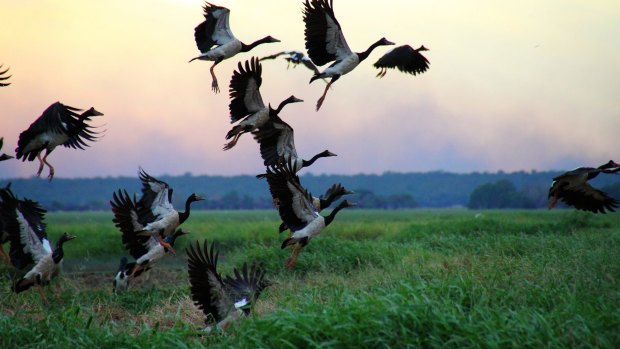
Magpie geese on Coopers Creek, Mount Borradaile.
A prehistoric spine and snout break the surface where some paperbarks and swamp palms are throwing their afternoon shade. In the nearby shallows, a wading egret keeps prodding for fish with a beak that the croc knows can destroy one of its magnificent eyes if it so much as thinks about snapping at a stick-thin leg.
A ruddy buffalo stares at our boat from a mud flat. A flock of glossy ibis takes off into the sun. Then our guide Rico Pascoe points out a tiny nest sitting on a midstream flatbed of lily leaves and we motor over to find it cradling two orange-and-black jacana eggs.
This is Arafura Swamp in north-east Arnhem Land – a vast place that has always belonged to the Yolngu and they have always belonged to it. It is full of story and song and ceremony and sacred places. It is Aboriginal land. And it is alive.
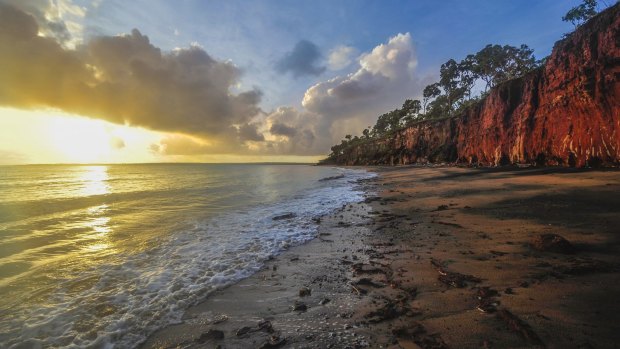
Rainbow Beach on Cobourg Peninsula.
Arnhem Land is a 97,000 square kilometre area in the Northern Territory to the east of Kakadu within that poised-wave piece of land west of the Gulf of Carpentaria. It indiscriminately encompasses the traditional lands of many language groups. The Yolngu, in the north-east, make up the majority of Arnhem Land's 16,000-strong population. There are towns in Arnhem Land but traditional owners are increasingly living on Country in small homeland communities.
Despite immense and often destructive changes forced on the people of Arnhem Land, especially over the last century, Aboriginal excellence flows into the mainstream from Australia's Top End. In all areas but, most distinctively, in the creative arts – often to international acclaim. Arnhem Land is also the birthplace of the yidaki (didgeridoo).
My introduction to Arnhem Land is on an Outback Spirit tour. A journey of more than a thousand red-road kilometres (and some liquid miles, too) from Nhulunbuy on the Gove Peninsula – Yolngu country – all the way to Iwaidja country on the Cobourg Peninsula.
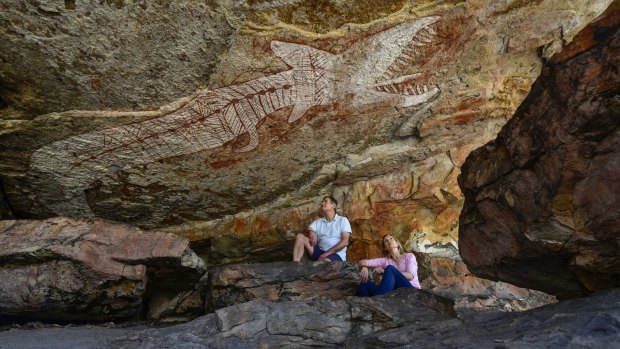
Rainbow Serpent site at Mount Borradaile.
NHULUNBUY AND YIRRKALA: WELCOME TO COUNTRY
Wintery morning mist lies so low for so long in Sydney that a handful of us arrive into Nhulunbuy a day late and miss the Welcome to Country in Yirrkala. We have to content ourselves with video snippets of the others learning dance moves on the sand to the beat of the clapsticks of Galpu lawman and master yidaki player Djalu Gurruwiwi. And of them relishing an immersive women's healing session in the sunshine with senior Gumatj Clan elders and their granddaughters. I had the option to get up north a day early and, in retrospect, I should have.
We step off the plane straight into the tropical Top End atmosphere. It's dry season – a time the Yolngu call Dharraddharradya – though it's only June so the real heat is yet to come. Nhulunbuy is a town of more than 3000 people and the largest in Arnhem Land. It's best known for mining and for Garma – an annual festival hosted by the Yothu Yindi Foundation when Yolngu come together to celebrate and share their culture.
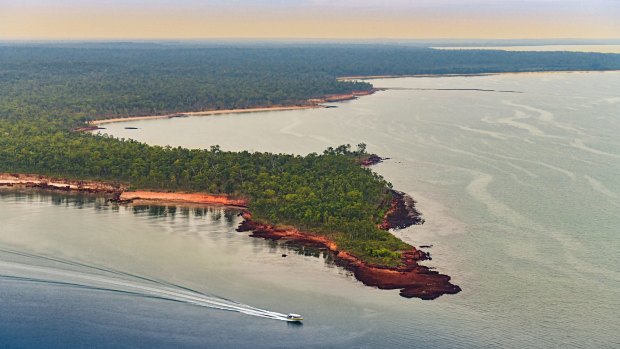
Cobourg Peninsula is now Garig Gunak Barlu National Park.Credit: Steve Strike
From the airport it's a 10-minute drive to the Indigenous arts centre of north-east Arnhem Land in Yirrkala. Many buildings are muraled with powerful impressions of the community's most significant people, including the face of Rirratjingu clan leader Roy Marika and the words "father of land rights".
Vanessa Spinelli opens Buku-Larrnggay Mulka for us even though it's Sunday. What began on the back of a truck a few decades ago is now several rooms of museum, gallery and printmaking. "The majority of artists paint on homelands," explains Spinelli, and most of the traditional paintings have been done on bark and stringybark poles.
On the museum wall is a replica of the Yirrkala Bark Petitions. When aluminium ore was found nearby in the 1960s and a mine approved with zero consideration for traditional owners, Roy Marika and others appealed to the federal government through these documents. Although ineffective at the time, it launched Australia's Aboriginal Land Rights Movement and sparked the homelands movement. There's also a Yolngu kinship poster I stare at for ages but can't decipher even though it's been dumbed down for a Balanda (non-Indigenous person) like me.
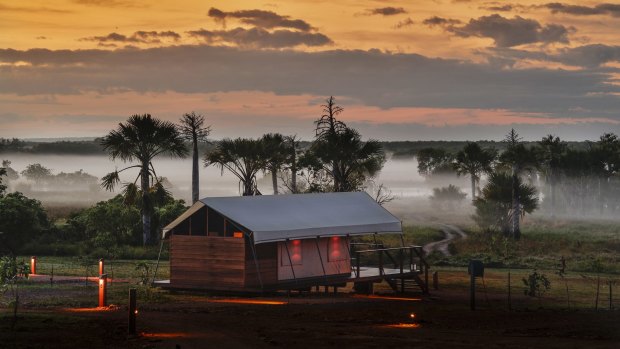
The safari suites at Murwangi are all beside Arafura Swamp.Credit: Steve Strike
That evening the whole group gathers at Walkabout Lodge. There are just over 20 of us from across Australia. Country people and city people. Some travelling solo or with friends but mainly couples. Tour director Ian Kaye is our driver, guide, fixer and feeder.
MURWANGI AND RAMINGINING: WATER WORLD
Early the next morning we kiss bitumen goodbye and hit Arnhem Land's "top road" then, later in the day, turn north on to a narrower track towards Arafura Swamp. The bushland is dominated by screw palms and towering termite mounds, slender stringybarks and semi-clad woolybutts. Crossing creeks, Ian Kaye slows to a crawl so we can look for crocodiles. He points out flowering swamp bloodwoods and turkey bushes. The occasional bright-eyed dingo watches us pass. Car bodies trigger a mixed response.
This is obviously the season for patch burning. Although traditional owners would have lit these slow-moving fires, it's the kites and falcons we can see through the smoke, flapping and perching, that are keeping the burns going. The birds relocate smouldering sticks to prolong their own hunting opportunities.
Murwangi was once a cattle station and is now a fancy camp with green grass and a neat line of wooden-floored airconditioned safari suites. The chef has prepared a three-course dinner of crocodile spring rolls, kangaroo wontons, barramundi, green ant panna cotta and lemon aspen brittle all served inside at a long table. We fall asleep in our suites under a half moon to the haunting noises of the swamp.
Traditional owners live and work onsite at Murwangi. Johnny Buniyira, who speaks Gunulbingu, comes on our four-wheel-drive tour the next day to teach us a thing or forty-two about his land. Camp manager, Leith Graham, follows with the English translation and together they make a great team. Like many Yolngu, Buniyira knows several languages but, although he's fluent in English, that isn't a language of the songlines that connect him to country.
Out on Arafura Swamp that afternoon, with Rico Pascoe at the bow, we see well over 50 species of birds including rainbow bee-eaters and wandering whistling ducks, blue-winged kookaburras and brahman kites, crimson finches and royal spoonbills. By September and October – the hot dry season of Rarranhdharr – this massive wooded wetland will support up to 300,000 birds. And there are always plenty of crocs.
Back on dry land I ask Buniyira where he was born and he points to a huge tree metres from the swamp and says his mother would build fires to protect him from roaming crocodiles. From a young age he worked here as a stockman, like his father. He tells me about the time he lived in Melbourne and how it took him "maybe one year" to miss bush tucker. "Today," he says with a grin, "is the season for magpie goose egg".
Remember that ground-breaking 2006 movie Ten Canoes? It starts with a fart joke told on a magpie goose egg hunting expedition and turns into an intense cautionary tale on the life-threatening dangers of lust. It was filmed right here on Arafura Swamp and Buniyira and his son Rico were both in it. Turns out Gunulbingu means Magpie Goose People.
Murwangi is near the community of Ramingining and, the next morning, we drop into Bula'bula Arts. Many artists are there to greet us when we arrive, weavers are already working on the verandah and upstairs is a Ten Canoes exhibit.
I talk with Joy Burruna, who is an artist and a centre director, in front of one of her long-necked goose pieces. She explains to me that her paintings tell the stories her mother and father told her. While working on them, she says, "I am hearing their voices all the time". Then master weaver Mary Dhapalany walks inside with a dillybag, just finished, hanging triumphantly on the back of her head.
BARRA LODGE AND MANINGRIDA: MAKING A SPLASH
There's no lunch until everyone catches a barramundi. We're beyond the tail end of barra season but Paul Doolan is determined everyone in our boat gets something hooked, photographed and released. This hardcore fisher still gets the shakes at the first bite of the day and could talk forever about the boofing sound barra make while they're implosion feeding – when they expand their mouth so rapidly everything in close proximity gets sucked in.
Meanwhile, Eagle Eye Stuart Ankin points out green monitors hiding in the exposed mangrove roots and white-bellied sea eagle nests and the shoreline middens of his ancestors. Around these parts, new mangrove shoots grow straight and strong in the water. We turn back at the confluence of three rivers you can just about see from the verandah back at Barramundi Lodge.
The safari suites of Barra Lodge, as it's known, are the same as Murwangi's but in an entirely different setting. Buildings are nestled in bushland, dining is outdoors and views extend down to the floodplains of the Tomkinson and Liverpool rivers. What was originally a pig and buffalo hunting camp made Lonely Planet's Best 500 Places to Eat in 2018. "Above and beyond anything else is the guest experience," camp manager Dave Coupe tells me.
This is Kunibidji country in West Arnhem Land. We spend the afternoon in Maningrida, built in 1949 as a trading post, where there's a footy match going on we're not permitted to attend. Arnhem Land is extremely linguistically diverse but Maningrida is off the charts: within a population of around about 2000 people more than 15 distinct languages are signed or spoken every day.
"Somehow we're all connected even though we've got different language," says Jessica Philips who shows us through Djomi Museum. The collection includes spears and woomeras, digging sticks and stone axes, fish traps and coil basketry, monochrome photographs and exquisite dilly bags adorned with brolga, bush turkey and cockatoo feathers.
Babbarra Women's Centre, also in Maningrida, opened in 1991 as a kitchen and has morphed into a screen printing and textiles workshop. From big things little things grow: Babbarra receives orders from Italian designers and exhibits its work in Paris. It collaborates with Australian fashion social enterprises and print houses for online sales but we just walk next door into their shop.
We've been joined along the way by cultural leader and educator Doreen Jinggarrabarra, who is queen weaver in this community of fibre art experts. She makes herself comfortable on the floor of Maningrida Arts & Culture to demonstrate how to split pandanus leaves, soften kurrajong bark and make string in preparation for the actual weaving. Doreen says that when she teaches the younger generation "we walk to look for pandanus instead of going in the car".
Around us are artworks by more than 100 artists from Maningrida and surrounding homelands including one of Doreen Jinggarrabarra's generously-fringed circular mats embedded with story. "We cry and we talk while we're weaving," she says. "Sometimes we make fun."
MOUNT BORRADAILE: ART ON A GRAND SCALE
"We get flocks of brolgas in their hundreds and thousands," says Lachlan Harrison as he motors us along Coopers Creek – a floodplain sustaining waterbirds and estuarine crocodiles and tolerating the hard hooves of wild pigs and buffalos. Mount Borradaile is not the most prominent mountain in sight but is the most significant.
Harrison eventually cuts the engine, cracks out the wine and points out the registered sacred site of Awunbarna (Mount Borradaile). It's a u-shaped mountain, he explains, with a cave system containing more than 100 burials and art, both inside and out. This whole area bears an abundance of rock art and, after what we've already seen today, the thought of Awunbarna up close blows my mind.
Mount Borradaile's sandstone face soon turns a deep orange while, on the other bank, a pair of brolgas dance in front of the sinking sun. And, as happens on the best of trips when good people come together and share something important, the group becomes family and everyone feels it.
Davidson's Arnhem Land Safari Lodge is set on a 700 square kilometre piece of leased land between the Arnhem Land escarpment and Van Diemen Gulf. Ulbu Bunitj senior traditional owner, Charlie Mangulda, lives onsite at Davidson's during the season but doesn't guide. He is now in his 80s and the last known Amurdak speaker.
The group has spent the day getting around in vehicles that could have been procured from the set of M*A*S*H and walking bush tracks to various rock shelters and outcrops and formations – one so labyrinthine it's called the catacombs. We've seen galleries of dynamic figures, hand stencils, cheeky yams, emus, catfish, magpie geese and Creation Beings. Ancient prints where children have put their tiny hand on Country. But also sailing ships and rifles.
A rainbow serpent six and a half metres long dominates the ceiling of one elevated shelter. The same space has sooty walls from domestic fires and parts of the floor are polished smooth from being sat on and touched and used by people – generation after generation – all the way up to not so very long ago. "This is how Charlie was raised on Country," I heard a guide say.
SEVEN SPIRIT BAY: AT JOURNEY'S END
For tens of thousands of years people thrived in Arnhem Land by collectively taking the concept of sustainable living to an unrivalled level of sophistication. Victoria Settlement, established in 1838 as a defence post and the third attempt at a northern settlement by the British Government, didn't make it past the 11-year mark. We wander its weathered coastal ruins during our stay on Cobourg Peninsula.
Seven Spirit Bay occupies a northern headland of the jointly-managed Garig Gunak Barlu National Park. For two full days it's our exceptionally comfortable base for more fishing and boat excursions, seafood barbecues on the beach and guided safaris to see the colourful cliffs of Rainbow Beach and spot wildlife. Even within the lodge boundaries are creatures like banteng and the nonvenomous Children's python the camp manager says his kids insist on bringing into their family cottage.
Getting to know your own country better is a very particular type of travel experience. Although the immersion in Arnhem Land's living cultures is over once we reach Seven Spirit Bay, there is time and space there for us to reflect on how far we've come.
"It's been an absolute revelation," says a gentle giant of a retired Queensland farmer the day before we fly to Darwin, "to come up here and see Aboriginal people living on Country and living well".
TRIP NOTES
Qantas, along with airline partner Airnorth, will get you from Sydney and Melbourne to Nhulunbuy/Gove via Cairns or Darwin. See qantas.com.au; airnorth.com.au
TOUR
Award-winning tour operator Outback Spirit was founded in 2000 by brothers Andre and Courtney Ellis. Along with bringing tourists to less accessible parts of Australia, Outback Spirit supports Arnhem Land communities by sponsoring football teams and creating jobs for local guides. Arnhem Land Wilderness Adventure is $13,695 a person twin share. Book before 31 December 2019 to save up to $1400 a person. See outbackspirittours.com.au; journeybeyond.com
FIVE MORE THINGS TO KNOW ABOUT YOLNGU CULTURE
THE CIRCLE OF LIFE
Kinship keeps everyone accountable. For instance, your aunts are all your mothers, great-aunts and great-uncles are all your grandparents, and, as a great-granddaughter, you are automatically the mother of your great-grandmother. Which makes a lot of sense if you think about it.
THE PERFECT FIT
Listen out for the words Yirritja and Dhuwa as you travel through north-east Arnhem Land. Yolngu see every Spirit Being, clan, person, place, species of animal, plant and fish and even the morning and evening stars as belonging to one of these moieties (balancing halves).
JUST SAY THE WORD
Yolngu Matha is spoken across north-east Arnhem Land and your attempts to speak it will be appreciated. Manymak (sounds like mine muck) is thank you, yo is yes, ma means good or OK. Saying hello isn't a Yolngu concept so hi is fine. If you hear "baru" then look around for a croc.
I TAKE YOUR SILENCE AS A NO
You should always ask anyone anywhere if you can take their photograph. And in Arnhem Land, even if kids are keen, you still need to ask parental permission. If the response seems unclear to you then that person is communicating their lack of consent.
MOST IMPORTANTLY
Yolngu recognise that everything is connected to everything. It's an ethos that, if shared worldwide, would undeniably have kept this Earth in far better shape than it is now.
FIVE TIPS FOR BUYING ART IN ARNHEM LAND
BEST OF THE BUNCH
All three art centres – Yirrkala, Ramingining and Maningrida – are excellent galleries without a souvenir in sight. Proceeds go only to the artist and the community.
WHAT'S THE STORY?
Gallery curators are fountains of knowledge so seek them out and it's always an enriching experience to meet and talk with the artist if you have the opportunity.
IT'S GOTTA BE LOVE
You can do your research and purchase the work of well-established artists or, alternatively, open yourself up to being blown away by what you see and then buying whatever you love.
MEASURING IT UP
It can be worth leaving home knowing exactly how big that empty piece of wall at home is rather than trying to make a guesstimate on the road, when a larger artwork really grabs you.
TO SHIP OR NOT TO SHIP
All galleries take credit card as well as offer shipping, which is advisable because the coach isn't set up for carrying much more than you and your bags.
FIVE AWESOME ARNHEM LANDERS YOU SHOULD KNOW
RARRIWUY HICK
This seasoned stage, screen and television actor appeared in Belvoir's 2019 production of Counting and Cracking. She grew up in both Sydney and the freshwater homeland community of Dhalinybuy.
BAYKALI GANAMBARR
Raised in Galiwin'ku on Elcho Island, Baykali is now an award-winning actor for his performance as Palawa (Aboriginal Tasmanian) tracker Billy in Jennifer Kent's film The Nightingale.
MAGNOLIA MAMINYDJAMA MAYMURU
From Yirrkala, Maminydjama is the first Aboriginal woman to represent the Northern Territory in Miss World Australia. She is also an ambassador for the Australian Human Rights Commission's Wiyi Yani U Thangani (Women's Voices) project.
LEILA GURRUWIWI
Gurruwiwi began as a reporter on Marngrook Footy Show at age 19 and has been a media presenter for more than a decade. She is currently co-producing an Arnhem Land based reality show about dance.
DANZAL BAKER
"I'm a proud black Yolngu boy with the killer flow/Listen to the yidaki, listen to it blow" – Marryuna (Let's Dance). The 2019 Young Australian of the Year, professionally known as Baker Boy, is the country's first Indigenous artist to have mainstream success rapping in Yolngu Matha.
Sign up for the Traveller Deals newsletter
Get exclusive travel deals delivered straight to your inbox. Sign up now.